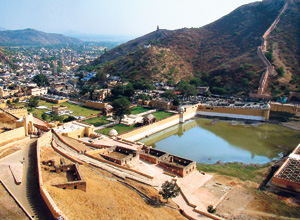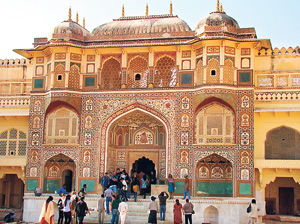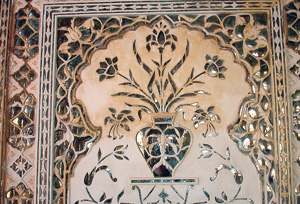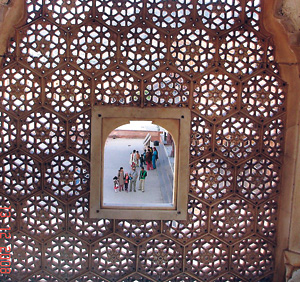On a visit to the Indian state of Rajasthan, we drove through forested areas to a rather dry and arid land, some 500 metres above sea level. Then suddenly before us was the Amber Fort. Nestled in the Kalikhoh range of hills, it is an edifice that reveals the grandeur of the Maharajas of Rajasthani descent.
This monumental structure had been home to several generations of Maharajas and their descendants. It can be traced back to the 13th century although what remains today are the remnants of the 16th century palace. Inside the Fort in this area of Amber, Maha Raja Man Singh built a spacious and beautiful palace.
When we arrived at the foot of the fort we had a choice - according to our guide, we could either get to the top on elephant back or opt to go in the vehicle. We chose the latter as the sun was beating down fiercely. We passed many elephants, gaily dressed with their faces and trunks painted with dark pink, blue, green and yellow designs, plodding along at a slow pace with tourists on their backs. It was a beautiful sight against the backdrop of the fort.
 |
| View from the top. |
 |
| The entrance to Amber Palace inside Amber Fort. |
 |
| The mirrorwork on the palace walls |
 |
| Queenly isolation: The window through which they could view the festivals at court |
The fort, with the palace within it has been home to many families of Maharajas and their kinsmen, down the centuries. The Moatha Lake is just beneath the Fort, and on a day when the waters are full, you can see the fort reflected in the waters. At the time we visited, the lake unfortunately, was almost dry. The fort has many terraces, levels, probably hundreds of rooms (in the palace), a labyrinth of passages and underground chambers, courtyards and gardens. Cobblestones pave the driveway and the front to the entrance. Massive brass lamps which resemble chandeliers, ornately carved, hang from various places in the ceilings.
Maharaja Man Singh had twelve queens for whom he built spacious suites which opened out into a courtyard. There are secret passages which connect and interconnect to other passages and where these would have lead, it was difficult for us to judge. Some of the passages were definitely private as there was hardly enough space for one person to pass. My 13-year-old son had the time of his life, exploring these stairways, crawling on his belly to get to places and he thought that Amber Fort was the most interesting place we had seen in India.
Maharaja Man Singh had been a connoisseur of the performing arts, literature and interior decor as is evident in all the living rooms of the palace. The ornate work on trellises and the walls of rooms decorated with gold and silver work, mirror work, coloured glass work and even powdered gemstone work was spectacular. The powdered gemstone work, which I had never seen before, was in very soft pastel shades of powder blue, green, pink and yellow and was very elegant. Super luxurious living would no doubt have been their lifestyle.
There is also a temple, within the precincts of the palace, dedicated to the Goddess Kali, to which devotees flock even to this day. In 1939, Maharaja Swai Man Singh, (the son of the former Raja Man Singh) donated a pure silver heavy door ornately carved and embellished with manifestations of the Mother Goddess as depicted in the Hindu scriptures.
The Maharaja had a House of Victory “Jai Mandir”, a sanctuary of sorts within the palace to be used in summer where fountains and cascades of water made it cool. The Mandir had ivory in-laid, carved sandalwood doors which remain even today.
In the lineage of the Maharajas, over generations, there had been marriages with members of the Mughal royalty and thus, the influence of Hindu and Mughal architecture is evident. Some of the buildings are of red sandstone and white marble and the designs and carvings in these stone combinations are extremely beautiful with red sandstone elephants, flowers and vines.
Raja Man Singh and his twelve queens had 35 children. The ladies could not directly come to watch all the festivals which were part and parcel of palace life, but had to watch through screens of filigree stone work, in which are small openings of ten inches by ten inches in length and breadth. It would have been rather a restricted life, although they were royalty. From viewing galleries several levels up, they watched the festivities taking place in the large courtyards below.
There was even a wheelchair of several centuries ago and our guide informed us that it may have been for very old ladies of the court or perhaps the pregnant ones. According to our guide Maharaja Man Singh, had had 200 concubines apart from his twelve queens. However this grand lifestyle came to an end due to several reasons. The Amber Fort had been abandoned due to lack of water at this high elevation and because, most descendents of the Maharajas could not maintain their standard of living in the present day and were unable to pay taxes to the government.
With so much of cultural value to be appreciated, the Amber Fort is well worth visiting, especially for children who would enjoy exploring its environs. |




